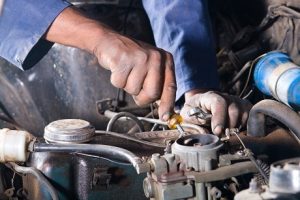Fleet Maintenance
Should You Outsource Service or Do It In-House?
One of the issues truck fleet managers have to periodically re-evaluate is the maintenance program. Is it better to handle repairs and maintenance in-house, or outsource service?
This decision to outsource or not is becoming ever-more complex. Newer machinery comes with onboard technology that gives drivers more behind-the-wheel information about the truck’s performance and telematics that communicate data directly to fleet managers and service techs. All that additional data is useful, but the electronics can significantly increase the cost of maintenance. The value of outsourcing also depends on the size and make-up of your fleet.
Advantages of an in-house shop
With a shop right at your facility and service techs on staff, you don’t have to send your vehicles elsewhere to get the work done. That’s faster and more efficient.
 For many fleet managers, however, it can be a matter of scale. Due to the increasing complexity and expense associated with service and repairs of newer, more sophisticated equipment, firms with smaller fleets find they can save money by outsourcing. In some cases, they are still retaining the most basic work such as oil and filter changes in-house.
For many fleet managers, however, it can be a matter of scale. Due to the increasing complexity and expense associated with service and repairs of newer, more sophisticated equipment, firms with smaller fleets find they can save money by outsourcing. In some cases, they are still retaining the most basic work such as oil and filter changes in-house.
Likewise, managers of large fleets are also choosing a combination of in-house and outsource service, although they tend to retain more preventive fleet maintenance and repair work, saving outsourcing for the largest, most complex jobs. Some large fleets continue to handle everything in-house under normal circumstances, but rely on outsourcing to handle “overflow” when their own facilities have too much work to complete quickly.
Fleet managers have to consider capacity and costs not only for routine service and mechanical repairs but for also for physical repairs and rebuilds, including body work and work on specialized components such as refrigeration or lift gates.
In many cases, it’s smarter to outsource service
Maintaining facilities and parts inventory is expensive, as are labor-related costs for service technicians and administrative support. These costs increase if your fleet includes vehicles from multiple OEMs.
And while regular maintenance requirements may be predictable, each vehicle in the fleet is on a different schedule, depending on its type, age, and usage. Further, unforeseen problems and repairs are, by their very nature, not predictable. When you outsource service, the shop is always ready and properly equipped when you need them. A top-quality shop can provide on-site repairs in many cases, keeping downtime to a minimum and eliminating transport hassle and costs.
Your dealer’s service technicians are the first to receive training from manufacturers, when it comes to new equipment and technology, so they are always up to speed on the latest techniques and best practices. With an in-house operation, every time you purchase a new truck for your fleet the service learning curve starts over – or at least backs up – while your techs get the training they need to perform regular maintenance and detect, analyze, and address problems. Training is expensive and time-consuming, and it’s ongoing.
And it’s not just training. To accomplish fleet maintenance work and repairs on newer machinery, you need specialized tools and a different array of parts. That increases both capital investment and operations expense. Your dealer’s shop has all the necessary equipment and supplies at hand. They’re part of a comprehensive parts network, so they have fastest access to any parts that might have to be ordered.
As an Elite service location for Freightliner and Detroit, our shops at Tracey Road Equipment can access data from a vehicle’s Detroit Virtual Technician diagnostic system. This provides in-depth information that makes streamlines and speeds service.
Each company’s fleet and finances are different, so determining whether in-house or outsource service is a truly individual decision. It comes down to finding the right balance of tooling, training, and facility capacity that will keep your fleet on the road and also achieve long-term financial goals.
